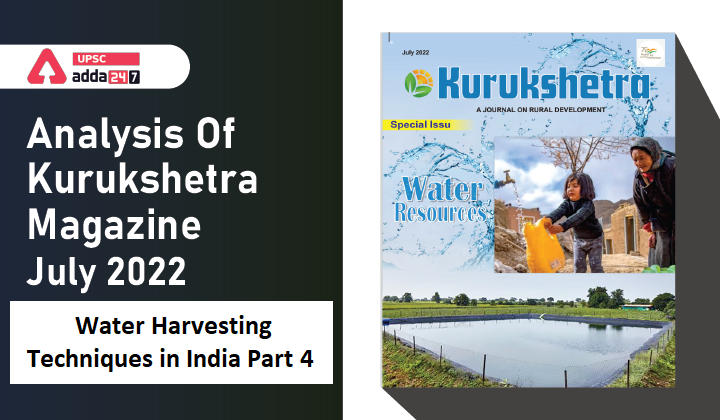Table of Contents
Kurukshetra is a Monthly Magazine which is issued by the Publications Division of the GOI.
Kurukshetra Magazine is one of the most important and indispensable source for UPSC Civil Services Exam Preparation. Keeping this in mind, here, we come with ”Analysis Of Kurukshetra Magazine” on daily basis, which covers the monthly Kurukshetra Magazine in easy and smooth pointed form, keeping in mind the demand of UPSC aspirants.
Considering the stern need of awareness regarding water resource management, the theme of this July 2022 special issue of Kurukshetra is Water Resources.
Water Harvesting Techniques in India: South India
Temple Tanks
- When we talk about water conservation practices in South India first picture comes to mind is of temple tanks. The temple tanks are known as Kovil Kulam in Tamil Nadu, Kulam in Kerala, Kalyani in Karnataka and Cheruvu or Pushkarini in Andhra Pradesh/Telangana.
- The temple tank is the focal point of several religious activities like the Theppam or float festival. Banks of the tank are also used for meditation and other rituals.
- It has been mentioned that Chennai city alone once had over 50 temple tanks constructed to harvest rainwater and prevent flooding. In addition to it there were several hundred Yeris (artificial tanks) to hold rainwater.
- The founder of modern Bangalore, Kempegowda built several tanks in and around the city.
Eri and Kulams
- The southern state of Tamil Nadu in India has a rich water resource heritage. Tamil Nadu has no perennial river that can cover the whole state. This inspired people to use monsoon rains for irrigation and filling the ponds for consumption and other purposes. It has been mentioned that approximately one-third of the irrigated area of Tamil Nadu is watered by the Eris (tanks).
- A large number of irrigation tanks were built between the 6th and 10th century A.D. during Pallava’s rule.
- If Eri is the broad irrigation tank, Kulam was the small pond close to a temple.
- Kulams were constructed by the local masons. A Kulam was built with bricks (and occasionally by granite) and was attached to a temple, giving it the name Kovil Kulam or temple tank.
Lakes or Yeris
A Yeri was a large earthenware tank dug out of the ground with the dugout mud making the side walls or bunds.
Ponds or Kuttais
- A Kuttai was a small pond. Anicuts (check dams) were small or medium dams built across rivers to divert water into irrigation channels.
- The Grand Anicut or Kallanai was built by Karikala Chola in the second century A.D. It was made of stone and situated on the river Cauvery where the River Kollidam branches off.
- The Anicuts in the Kanyakumari district were built many hundreds of years ago.
Surangam(tunnel)
Surangam is a horizontal cave excavated in the mountains with super-condensed soil or rocks. The excavation itself is a tedious endeavour.
Kudimaramathu
- Kudimaramathu is one of the old traditional practices of stakeholders participating in the maintenance and management of irrigation systems.
- In this, citizens of a village participate in maintaining the water bodies of their village by deepening and widening the lakes and ponds and restoring them back to their original form.
- The silt, rich in nutrients, collected in the process is used by the farmers themselves in their field. A sense of collective ownership ensured the continued survival of the water bodies.
Water Harvesting Techniques in India: The Islands
Jackwells
Nicobar’s physiography, topography, type of rocks and variation in rainfall, has encouraged the local tribes to develop different water harvesting structures. The split bamboos serve as channels for rainwater that is collected drop by drop in pits called Jackwells.
Water Harvesting Techniques in India: How To Revive Water Bodies?
Important actions and consideration that need to be undertaken to revive water bodiesare as follows.
1. Focus should be on sustainability. Therefore emphasis should be on long-term goals, operation and maintenance, adequate budget, and ownership and responsibility to the people.
2. Economic, environmental and social impact of the project should be studied in detail before hand and reviewed in between for the course correction, if needed. Local communities need to be involved in all these planning and reviews.
3. Encouraging local people to collaborate with other stakeholders to successfully utilise resources should be done to ensure the protection and conservation of water bodies.



 TSPSC Group 1 Question Paper 2024, Downl...
TSPSC Group 1 Question Paper 2024, Downl...
 TSPSC Group 1 Answer key 2024 Out, Downl...
TSPSC Group 1 Answer key 2024 Out, Downl...
 UPSC Prelims 2024 Question Paper, Downlo...
UPSC Prelims 2024 Question Paper, Downlo...
